One of the best ways to determine different species of sharks is by looking at their fins.
All sharks have the same types of fins to help them navigate the waters and hunt more effectively. Their fins have evolved over millions of years and all have a specific purpose. So to help understand how sharks use their fins and to help recognize different types of sharks by their fins, we have put together this guide so you can understand shark fins.

Evolution Of Fins
Shark fins have developed over 450 million years of evolution. The very first known shark, the Xenacanthus, more closely resembled an eel than a modern shark. The Xenacanthus had a ribbon like dorsal fin that ran down the length of it’s back and connected with its anal fin. Fast forward a hundred million years to the Cladoselache which had evolved four dorsal fins along its back. Nature then got really creative around 330-320 million years ago and created an interesting variety of dorsal fins from the unicorn like horn of the Falcatus to the dorsal fin of the Stenthancantus that looked like an spiked anchor. It wasn’t until around 100 million years ago, that shark fins started to really resemble what they are today. These fins developed as a result of environmental pressures and helped ensure that sharks would have truly efficient fins.
The Biological Structure Of Fins
Shark fins are long and stiff. They are attached to the body with cartilaginous rods that extend off the skeletal frame of the shark. These cartilaginous rods are called ceratotrichia, and help support the strength and rigidity of the fins so they help sharks swim quickly and with impressive agility.
Types Of Shark Fins
Shark fins come in a unique range of sizes and shapes, however all sharks have basically the same fins. Sharks all have a pair of dorsal fins, a pair of pectoral fins, a pair of ventral fins, and a caudal fin. Some different species of shark also have a singular anal fin. Understanding how to recognize each type of fin and how they help a shark navigate through the water is crucial to understanding the biology of sharks.
First Dorsal Fin
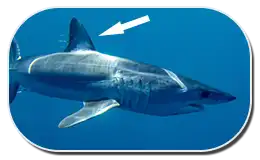
The first dorsal fin, also known as the “cranial dorsal fin,” is the fin most people think of when they think of sharks. The first dorsal fin is the fin that Hollywood movies always portray as cutting through the surface of the ocean like a knife. The first dorsal fin is located on the top of a shark’s back and is used to stabilize the shark in the water. Lined with strong, flexible dorsal fibers, the first dorsal fin keeps a shark from rolling on it’s back and helps it make sharp turns while swimming fast.
Second Dorsal Fin
The second dorsal fin is much smaller than the first dorsal fin. The second dorsal fin is located on the back of the shark midway between the first dorsal fin and the tail. The second dorsal fin, much like the first dorsal fin, helps to stabilize the shark in the water. The second dorsal fin helps the shark swim steadily and maneuver the back of it’s body more easily.
Pectoral Fin
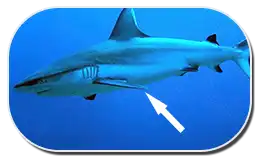
Pectoral fins are often thought of as the wings of a shark. They are the pair of fins located on either side of the body along the pectoral muscle line. The pectoral fins control the direction the shark swims and help maintain balance in the water. Pectoral fins help the shark make turns, swim up or down, and roll its body. Depending on the species, the pectoral fins are also usually the largest fins on a shark.
Ventral Fin
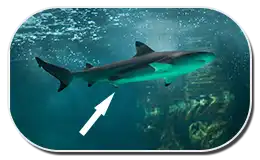
The ventral fin, or the pelvic fin, is found in pairs along the underneath side of a shark’s body. Ventral fins are usually located along the side of the body between the pectoral fins and the tail and are smaller than the pectoral fins. Ventral fins, like pectoral fins, help sharks turn, go up and down in the water, and roll.
Anal Fin
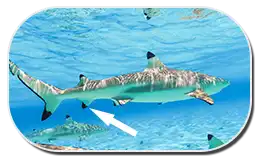
Anal fins are not present on all shark species. On the sharks that have anal fins, there is usually only one anal fin located on the underneath side of the shark right before the tail. Anal fins are generally small and shaped like dorsal fins. Also like dorsal fins, anal fins help aid in stability in the water.
Caudal Fin
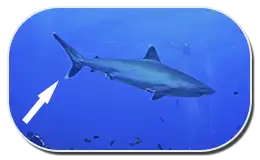
The caudal fin, or tail fin, is the fin located at the top of the tail. The caudal fin is used for propel the shark forward, increasing or decreasing speed, and thrust. The caudal fin is broken down into two parts, the top half known as the dorsal portion and the bottom half know as the ventral portion. On sharks the dorsal portion of the caudal fin is always larger than the ventral portion because the spinal column runs through the dorsal portion, allowing for more muscle development and use. On some species like the Thresher Shark, the caudal fin is also used for defense and to help kill prey.
Types Of Shark Tail Fins
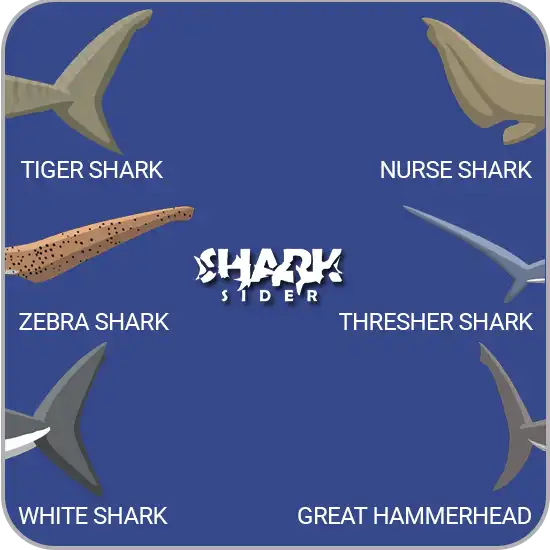
Shark Fin Diversity
Though different species of sharks all have the same basic fins, the size and shape of a shark’s fins are incredible diverse. For example, some species of ground sharks like Catsharks have dorsal fins located closer to their heads rather than their tails. Sharks like Angel Sharks and Wobbegongs have pectoral fins large enough they are often mistake fro rays. While the Thresher Shark’s Caudal fin is so long, it literally uses it to slap and stun prey and predators. It is this diversity of fins that help scientists categorize and label the different species of sharks.
Understanding the types and purpose of the different shark fins, helps you understand how sharks are able to move through the water so gracefully. Though the size and shape of a fin may vary among different species of shark, all sharks generally have the same fins. These fins are an amazing biological adaptation that have helped sharks dominate the oceans for hundreds of millions of years.
